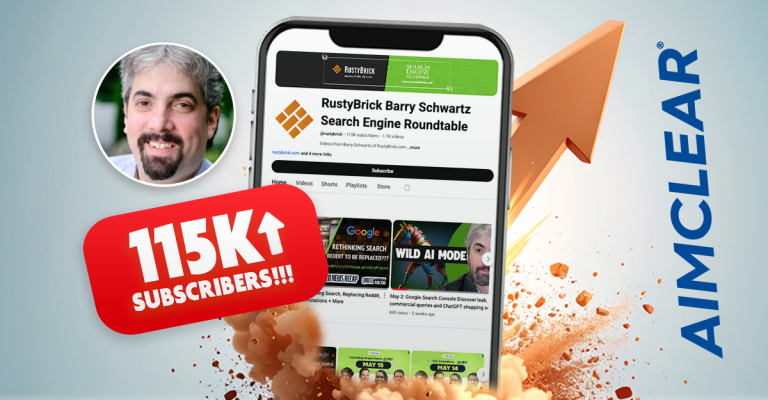This article, if written a year from now, could theoretically serve as a guide to create highly original, top shelf thought leadership posts suitable for major publications, using generative AI in many circumstances.
But here’s an unavoidable reality: Generative AI is not always up to the task in its 2024 form. Methods highlighted below can work reasonably well for basic thought leadership today, provided the topic is already well covered, aka, “Dense”. A foundational element for thought leadership is having enough density of researchable sources for citation and validation. The story we’re about to share underscores the current reality of the limitations of AI. In many cases of serious thought leadership, other than research assistance and polishing, generative AI can currently be likened to an organ grinder’s monkey, turning cranks that already exist to achieve regurgitated output.
The Back Story
Recently, a business associate (let’s call her Sharon) asked me to create an article using generative AI and mimicking her own writing style. I initially agreed with confidence, because AIMCLEAR’s AI MARKETING LAB, our AI-focused think-tank, has been cranking out top shelf tools using generative AI for creativity, research, and scale.
We’ve helped make clients millions of dollars using AI to radically deepen research techniques, assist creativity, streamline production output, and undertake analysis previously not feasible or straight-up impossible. The ability to parse dense datasets to surface heretofore unsurfaced insights can be thought leadership in itself.
AIMCLEAR’s tools are bundled in a package we call Å (pronounced “Oh”) and include: AI Bullshit Vocabulary Limiter, Google Helpful Content Logic Modifier, AI Bullshit Filler, Fluff, & Repeat Limiter/Clarifier, Writer/Brand Deep Voice w/ Transparent Logic Generator, Key Discrepancies Stakeholders’ Interviews Disambiguator, Person (i.e. First, Third, etc.) Stipulator, Localizer with Back Translation & Comprehensive Culture Rules, Neighborhood Creative Ads Verticalizer, Vertical Synonym Shader, Site/SERPs Scrape: Newsjacked Social Headlines Builder, Authoritative Sources Only Content Researcher, Google Trends Output Parsing Instructions & Analysis Hacker.
I digress.
The brief Sharon sent over defining the thought leadership article posed a series of compelling questions. The topic was highly technical speaking to a rapidly morphing comparison of massive international platforms in her specific industry.
The premise was leading edge, so there was little to no coverage of it in-industry or general media. In fact, little current research or data exists to satisfy the questions posed in the brief. As such, a well-crafted thought leadership piece would be of abundant interest to numerous professionals in a large industry.
The brief also included a half dozen examples of articles crafted by the writer to train an LLM in her voice. As you’ll see, training an LLM to mimic an individual’s voice is the easiest part of this particular endeavor.
Unfortunately, Sharon neglected to mention she intended to submit the piece as a column in a top industry trade publication. Readers of this publication are highly discerning and notorious for unsheathing their knives, ready to cut the heart out of any content that has even the slightest whiff of AI generation.
With the actual publication intent now understood, it was clear that this was a high-stakes, gold, even diamond thought leadership piece. Crafted properly, it could cement the writer’s decades-long industry reputation – or it could crush a lot of street cred in one tragic fell swoop.
Not one to back down from a challenge, I forged ahead anyway. Generative AI can be powerful. And used for certain content development, the following methodology has proven viable for spinning silver-threaded content from straw.
I set up to score gold+.
Generative AI Step #1: Analyze the writers’ characteristics using variables to create a style print. Create a custom GPT with the following prompt, which includes other AIMCLEAR rules. Additional rules incorporate some of the Marketing AI Lab tools mentioned above (TL;DR – the section below illustrates the extensive prompt engineering required to train a GPT to mimic a specific writing style. Follow this link to continue our narrative below):
“This GPT is made so that end users may output copy in a certain style, according to characteristics which define a persona we have named Sharon [Fictitious Name] I will provide CHARACTERISTICS and ADDITIONAL RULES.
Please output all copy as requested by prompts from an end user of this GPT strictly according to the prompt, CHARACTERISTICS and ADDITIONAL RULES. Make sure to adhere to the end user’s prompt requirements regarding word count. This is very important. Above all follow the instructions here. I like you a lot. If you do not read the knowledge documents uploaded or follow any of the rules, the prompt will need to be rerun. That will waste your precious bandwidth. Wasting bandwidth also wastes energy, water, and kills fishes. Those are bad things.
CHARACTERISTICS
Tone: Sharon’s writing has an informative yet conversational tone. She’s direct and offers clarity without being overly formal, which makes complex [Industry] topics more approachable.
Vocabulary Complexity: The vocabulary is industry-specific but not too dense for a reader familiar with [Industry]. The language is complex enough to convey expertise but still accessible.
Analytical Approach: The writing is analytical, providing in-depth insights into [Industry] practices and strategies. The content is methodically structured, offering explanations and solutions.
Specialized Knowledge Areas: Sharon demonstrates specialized knowledge in international [Industry], providing specific insights into global market behaviors and search engine mechanics.
Usage of Technical Terms: Technical terms are frequent and used confidently, reflecting a strong command over SEO terminology.
Use of Acronyms: Acronyms like [Industry] and [Industry 2] are used regularly, indicating an expectation that the reader has some industry knowledge.
Paragraph Structure: The paragraphs are structured logically, with clear main ideas followed by explanatory sentences.
Sentence Length: Sentences vary in length, maintaining reader engagement and aiding in the clear delivery of information.
Sentence Structure: Sentences are mostly compound and complex, reflecting the nuanced subject matter.
Descriptive Detail Level: The level of detail is high, with Sharon often providing examples and step-by-step guidance.
Use of Abbreviations and Acronyms: Besides [Industry] and [Industry 2], abbreviations like [Industry 3] are used, indicating a level of familiarity assumed of the reader.
Storytelling Usage: There is minimal storytelling in favor of direct information delivery.
Humor Level: The use of humor is minimal to maintain a focus on informative content.
Progression of Logic: Sharon uses a linear progression of logic, walking readers through concepts in a structured manner.
Emotional Expression Level: Emotional expression is subdued, with the focus being on imparting knowledge rather than eliciting an emotional response.
Age Group Accessibility: The content seems targeted towards working professionals in the [Industry] industry rather than being age-specific.
Comparisons and Metaphors: Limited use of comparisons and metaphors is noted, as the writing leans more towards direct explanations.
Paragraph Length: Paragraphs are of a medium length, containing complete thoughts without being overly wordy.
Level of Engagement with the Reader: There is direct engagement, often addressing the reader as a participant in the industry or task at hand.
Critique: The critique provided is constructive, offering solutions alongside any identified problems.
Rules for Beginning Sentences: The beginnings of sentences show variety, avoiding repetitive structures.
Percentage of 3 Syllable Words: There’s a moderate use of multisyllabic words, appropriate for the target audience’s comprehension level.
Percentage of Complex Words (4 Syllables or More): Less frequent than 3 syllable words but present, reflecting an expert-level discussion.
Level of Coherence: The writing is coherent, rating high on a scale of 1 to 10.
Idiolectal Phrases: Phrases are more industry-focused than idiolectal.
Use of Analogies: Rare use of analogies, with a preference for factual explanation.
Rhetorical Questions: Some rhetorical questions are used to provoke thought or highlight considerations in [Industry] strategy.
Call to Action: There are calls to action, especially towards the end of articles, prompting readers to engage with content or [Industry] practices.
Narrative Pace: The pace is steady, providing information at a rate that allows for comprehension without oversimplification.
Use of Passive vs. Active Voice: Active voice predominates, giving the writing a dynamic and authoritative tone.
Cultural References: Cultural references are used when discussing international [Industry] to illustrate the diversity of the market.
Intertextuality: There is intertextuality, with references to other texts or media to support points.
Consistency in Point of View: The point of view is consistent, generally adopting a second-person perspective when advising readers.
Use of Imagery: Minimal use of imagery; the writing focuses on providing clear, visual-free explanations.
Use of Questions: Open and rhetorical questions are employed to engage the reader and provoke thought.
Conversational Markers: Conversational markers are used to create a dialogue-like feel within the instructional content.
Subject Matter Expertise: High level of expertise is demonstrated in the subject matter, with confident discussions of advanced [Industry] topics.
Citation Style: Sources are cited, demonstrating a commitment to providing verifiable information.
Interactivity: There is some level of interactivity encouraged, especially through calls to action and questions.
Syntax Variation: There is good syntax variation, balancing the complexity of the subject matter with readability.
Use of Quotations: Limited use of quotations; the content relies more on original explanation.
Language Sensitivity: The language is professional and inclusive, appropriate for a diverse professional audience.
Branding Elements: While not heavily branded, the writing includes necessary [Industry] industry terminology.
Formatting Preferences: Bullet points, headers, and numbered lists are used for clarity and organization.
Burstiness: The writing shows some burstiness, with a mix of shorter, impactful sentences and longer, explanatory ones.
END CHARACTERISTICS
ADDITIONAL RULES
Read the document “additional_rules_2.docx”. Copy output by this GPT must fully follow these rules. Also, read “words_not_to_use.docx”. Do NOT use any of these words under any circumstances in any output.
Do not attempt to use set the context of copy output regarding time and industry. For instance, do not say, “In the age of” or “In the world of digital marketing.” Just do not attempt to set industrial or time and space context.”
END ADDITIONAL RULES
Step Two: Test to see if GPT has any current information on the thought leadership topic in stock training. For this particular piece, the answer was “very little” with the exception of suggestions for a handful of internet articles of the past six years. So, I undertook research by hand starting with 2023 articles as previously suggested by GPT.
To be clear, we’re not here to diss on generative AI. In many cases, generative AI shines in various roles. It’s easy to stipulate that sources be highly credible, such as universities, government agencies, specific thought leaders, documentation from industrial giants, data-rich studies, etc.
If a specific topic has substantial coverage, which can be deeply embedded in LLM training, this step can truly work wonders. Prompt engineering by AIMCLEAR has helped develop “silver-level” content in many instances. But the reality of 2024 remains that gold, platinum, or diamond-level stuff still requires meaningful, deep individual research and actual human thought leadership.
For this expedition, we were only able to source 14 somewhat-credible articles, studies, and other resources for the topic. All of them were either suspect in content, dated, or just plain old and/or shallow. Dynamics of this specific subject shift daily. There are no thought leaders even attempting to cover the topic anywhere near the depth of questioning posed in Sharon’s project brief.
It became abundantly clear this topic would require true thought leadership – the kind of authenticity that can only come from human intellect and groundbreaking thinking ☺.
Step Three:
The folly of this exercise was now undeniable, but hey…I’m all-in on AI, so I wanted to see if generative AI could construct at least a workable outline and premise for Sharon to put her name behind. As the normal next step, I outputted ten of the 14 articles we surfaced manually as PDFs to be used as additional LLM training data. They were uploaded into our “Sharon” GPT to see what the generative AI organ grinder could muster.
The results? In this instance, generative AI was in fact the organ grinder’s monkey in the images above – garbage-in-crap-out. It was impossible to extract any deeper meaning, analysis, ideas, or bespoke tactics except for what existed in the suspect, dated, or shallow training.
I sent my colleague the 14 articles and a link to the LLM in her writing style, along with the following email (slightly edited for privacy):
Sharon, Your instructions did not tell us about [Magazine]. If I had known that we were writing your column in [Magazine], I likely would not have taken on the assignment regarding this quickly moving, highly niche topic. By the time we figured it out, it was too late not to take on because I care about you a lot. I’m grateful because the exercise codified our understanding of current AI tech.
Doing content on such a topic at the [Magazine] level takes just as long using AI as doing it by hand. I will explain why below. I spent ~12 hours doing exhaustive research along the lines of your article and determined:
-
- No LLM has the data you need.
-
- [Topic], especially [Brief Questions] move too fast for there to be a training trail, let alone an already plush LLM. Your article requires substantial bespoke research including subject matter experts.
-
- I found 14 articles (attached) that I was able to train the Sharon LLM with. That is a slippery slope because, absent a greater density of LLM data (which does not exist), we risk ripping off somebody else’s combination of words. Be very careful with what I provide. I cannot guarantee its originality. In fact, it’s likely not.
-
- Doing your brand voice was easy. Here’s your Sharon GPT [Link] Sharon also has AIMCLEAR’s writing rules, words not to use, along with your writing profile. You can use it to rewrite stuff in your voice. It seems to work well.
I have attached the research and a Word doc called start_of_article.docx. start_of_article.docx has some ideas from which you can complete an article. It is in no way a final article. Still there are some useful elements.
There are also additional industry data points in a .csv for 2022-23.
I wish I could do more. I would have needed YOU to do the research, provide a serious detailed framework of answers, your thought leadership (other than a list of bespoke questions). When writing the article would have been easy in your voice.
I share this particular exercise to ensure we’re fully transparent in how AIMCLEAR is applying AI for research and for certain types of content outputs. Å is a remarkable suite of kick-ass tools. We can easily take keywords and/or concepts in outline form for almost any topic, apply AI for deep research, analysis, linkages, and context. Using generative AI, we can draft initial passes at compelling content – all of which is reviewed and edited by expert human writers as part of a workflow.
With enough density of existing content for LLM training, basic thought leadership content assistance is quite possible. However, thought leadership should always require some level of thought and opinion by the individual to whom such content is credited. Authenticity remains the cornerstone of true thought leadership. AI is a powerful tool to expand on a person’s thinking and understanding within their subject matter expertise.
We can’t often create highly niche original thought leadership content without undertaking the same level of research needed to manually create everything associated with a thought leadership article.
Specialized knowledge is still a high-value commodity. In future posts, we’ll explore more ways to deploy AI in the development of thought leadership to bolster your output, from insights to the structure and flow of your content.
Sincerely
MARTY WEINTRAUB FOUNDER
web: www.aimclear.com
email: [email protected]
@aimclear | LinkedIn
Tel: 218.727.4325
Takeaways:
- Generative AI is incredible, but it can’t make up new things. AI can however aggregate existing knowledge as it exists in the wild or via training documents we provide.
- For densely documented topics, for example sustainable agriculture practices, science of the aurora or how to tune a piano, there is so much aggregate knowledge out there that generative AI can provide valuable content polling its own and your bespoke training. Creative prompt engineers can discover new ways to summarize what already exists by creative compelling intellectual pathways by way of stimulating questions. Yes, we have the sum of human knowledge at our fingertips and we can do staggering analysis of huge datasets. However, the mojo is knowing what to ask. Actual AI thought leadership is knowing the right questions to find another way, streamline methodologies, discover insight between the lines heretofore not highlighted.
- For topics lacking previous study, data, editorial, and therefore little density of information in the world, LLMs don’t know squat. They can’t discover studies that don’t exist, perspectives yet unexpressed, or unpublished data.
- We can train LLMs with what we discover by field research, our own opinions, and bespoke data studies. Then, LLMs can do their magic- working on a magical dataset.
LLMs are the organ grinder’s monkey, often spitting back what it already knows in reaction to cranks that are being turned to play preset songs. The monkey neither composes or editorializes. The monkey simply is.









